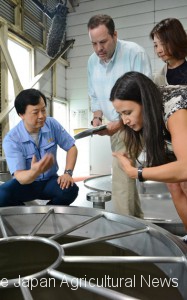
Buyers of alcoholic beverages from the United States talk with a distiller in Hitoyoshi, Kumamoto Prefecture, during a tour organized to increase recognition of shochu in overseas markets.
KUMAMOTO, Oct. 30 – Japan External Trade Organization’s office in Kumamoto Prefecture is seeking to boost exports of the local flagship specialty shochu liquor distilled from rice. It organized a tour in early September for alcohol buyers of washoku Japanese restaurants in the United States to visit distilleries in the prefecture.
The tour was aimed at familiarizing foreign buyers with the flavor and the efforts that go into production of shochu which, unlike Japanese sake, is still little known abroad. JETRO also supports local distillers conduct market research and develop sales strategy for the U.S. market so that their products can compete with South Korean soju liquor which enjoys strong sales in the U.S. market.
JA Kuma, an agricultural cooperative in the prefecture which provides rice for shochu production, hopes the initiative will also help increase demand for rice.
Three people involved in the distribution and purchase of Japanese liquor in the U.S. participated in the three-day tour. Guided by a JETRO official, they visited six places in the prefecture, including Takahashi Shuzo Co., Ltd., a long-established distiller of Kuma shochu in the city of Hitoyoshi, and Zuiyo Co., Ltd. in the city of Kumamoto which produces Akazake, a traditional reddish rice wine.
The participants, each of them accompanied by an interpreter, asked questions to distillers and brewers regarding the rice and yeast varieties they use and the production process. They also checked the flavor and the smell of the liquor under production, as well as other details such as the differences of brands, the production volume and how the products are labeled for export.
Producers of rice used to make shochu are also counting on exports to boost demand for such rice. JA Kuma has been producing rice for shochu production since 2004 in cooperation with local farmers and the Kumamoto Prefectural Government. This year, it made a contract with 13 distilleries to sell a total of 390 tons of rice. Starting next year, it will set on full-scale production of a high-yielding variety Tachiharuka to respond to a growing demand for rice used to make Kuma shochu which is registered as a geographical indication.
“If rice shochu becomes widely recognized also in foreign countries, it will encourage rice growers,” said a JA Kuma official.
Many distillers and farmers suffered damage by the strong earthquakes that hit the prefecture last year. Some farmers cannot resume rice planting because cracks in the paddies and destroyed irrigation channels remain unrepaired in some places.
“Seeking demand in overseas markets is a great way to realize creative revitalization in the region hit by the earthquakes,” said an official of JETRO’s Kumamoto office. “Through this project, we want to enhance rice farmers’ interest in exports.”
According to JETRO, shochu exports totaled 1.5 billion yen last year in terms of value. There are still room for the exports to increase, considering that exports of Japanese sake amounted to 15.5 billion yen the same year.
Their biggest rival is South Korean soju which boasts hefty sales in the U.S. market. To compete in the market, JETRO, along with Japanese trading firms and distilleries, established a shochu export promotion council in Los Angeles in August to conduct market research and sales campaigns in the U.S.

